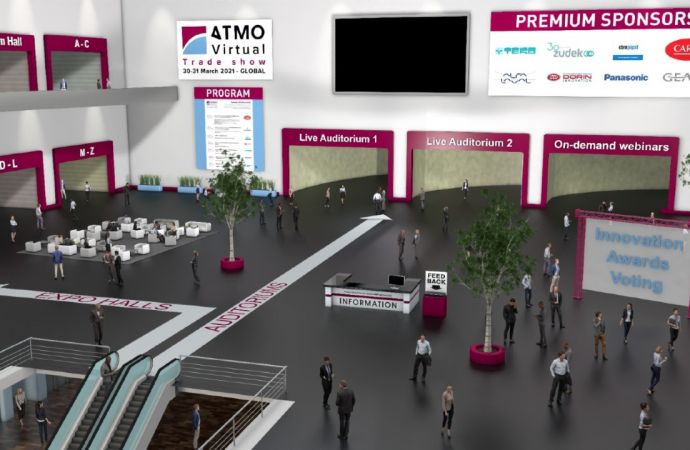This year saw several remarkable events around the globe focusing on ammonia as refrigerant and showcasing new developments. Among them, the 4th edition of the IRR International Ammonia Refrigeration Conference that took place in April 2011 in Ohrid (Macedonia); the 23rd IIR International Congress of Refrigeration (ICR) held in August 2011 in Prague (Czech Republic), and ATMOsphere Europe 2011 that happened in October in Brussels (Belgium). Here is a summary of major outcomes of these events.

IARC - Ohrid
More than 100 delegates from 33 countries gathered in Ohrid for the 2011 Ammonia Refrigeration Technology conference.
The IIR spokesperson, Didier Colomb, underlined the importance of ammonia technology in the context of the review of the EU F-Gas Regulation and the Montreal Protocol negotiations that are aiming at putting greater restrictions on high GWP substances.
Alfa Laval presented ways to obtain low ammonia charges in a plant by minimising the charge in the evaporator and separator vessel. The main advantages with the U-turn are the compactness and the impact on energy efficiency. However, it was also shown that the design makes it furthermore possible to reduce the charge in the evaporator and separator. Alfa Laval has thus been able to develop a very compact flooded system with increased efficiency by enabling higher evaporation temperatures and at the same time reducing the refrigerant charge to a minimum.
Webster from Kraft Food explained that properly designed, maintained and operated ammonia systems can be very safe. For good maintenance purposes, it is extremely important to layout equipment with ample working distances and clearances. He concluded saying that a good preventative maintenance programme for ammonia refrigeration systems and equipment provides safety, reliability and longevity of the system.
Ammonia plants are often designed to run with evaporative condensers only. Josef Riha from Güntner reminded that the option of using air-cooled condensers exists and has certain clear benefits. Air-cooled condensers require less maintenance, while no water for cooling needs or chemicals for water treatment are needed to operate them.
Alexander Cohr Pachai from Johnson Controls argued that it is a viable solution to use heat pumps in many applications for the production of hot water or hot air. Challenges mainly reside with larger temperature differences in the system and the type of insulation materials used. Once these issues are overcome, the market potential of heat pumps is huge and they can compete with boilers from a cost point of view.
Predrag Hrnjak, University of Illinois USA, focused on charge reduction in heat exchangers, especially microchannel condensers, along with the use of newly developed hermetic compressors. This system allows for ammonia as a refrigerant to be used in urban areas.
ICR – Prague
Prague hosted the 23rd IIR International Congress of Refrigeration (ICR) in August 2011 to present updates on research and commercial viability of refrigeration systems.
Mayekawa covered a presentation on the development of optimised low-pressure ammonia scroll compressors. Assuming a fixed cylinder diameter of 155 mm, the researchers from Mayekawa have identified the design dimensions (including the involute base circle radius and the scroll height) of the scroll configuration that lead to optimum efficiency. An involute base circle radius of 4.6 mm was found to give an overall efficiency of 81.0%, representing an efficiency improvement of 1.07% compared to a high-pressure compressor.
Dr Cotter, From Star Technical Solutions identified the following advantages of a low-pressure receiver system with air coolers over the pumped recirculation system:
Finally, a study undertaken to incorporate an ammonia-based heat pump that would use waste heat from the refrigeration cycle to boost pasteurising temperatures and thereby remove the need for a natural gas boiler was presented by Mr Unsworth from GEA. He explained the main characteristics and design issues related to replace an existing R22 plant with ammonia, combining heating and refrigeration. A heat pump was designed to achieve the required water temperature of 80°C and use a reciprocating compressor for higher efficiency. The feasibility study showed a net saving in utilities and a return on capital expenditure of 1.5 years.
ATMOsphere Europe 2011 - Brussels
In October 2011, Brussels hosted the third edition of ATMOsphere, an international, interactive workshop dedicated exclusively to natural refrigerants. This year the focus was on Europe, and included two policy sessions to discuss the recently launched European Commission F-Gas Regulation consultation and new Eco-Design requirements. The packed programme also included end-user panels, moderated workshops and technology sessions.
Dave Pearson of Star Refrigeration presented results from the application of a high-pressure heat pump solution using ammonia screw compressors for reducing the Nestlé UK Halifax factory’s refrigeration and heating energy demands. The project saves annually £250,000 (~€299,640) on operating costs, allowing a 4-year investment payback period.
European Eco Design regulations have the potential to address not only product efficiency, but also refrigerant emissions. Discussions at ATMOsphere Europe 2011 underscored, however, that more active involvement of the industry in the regulatory process is needed, if the precedent of including a low GWP bonus in the regulation for room air conditioners is to be replicated.
The End-Users session gathered several unique perspectives on natural refrigerant projects. Presentations from The Coca-Cola Company and Unilever voiced a clear commitment to natural refrigerants, whilst CSR-i explained their value to “future proof” a business. Robert Wiseman Dairies were invited to present a pioneering ammonia heat pump project.
A similar ATMOsphere event focusing on natural refrigerants will take place next June 2012 in Washington DC, USA.
More than 100 delegates from 33 countries gathered in Ohrid for the 2011 Ammonia Refrigeration Technology conference.
The IIR spokesperson, Didier Colomb, underlined the importance of ammonia technology in the context of the review of the EU F-Gas Regulation and the Montreal Protocol negotiations that are aiming at putting greater restrictions on high GWP substances.
Alfa Laval presented ways to obtain low ammonia charges in a plant by minimising the charge in the evaporator and separator vessel. The main advantages with the U-turn are the compactness and the impact on energy efficiency. However, it was also shown that the design makes it furthermore possible to reduce the charge in the evaporator and separator. Alfa Laval has thus been able to develop a very compact flooded system with increased efficiency by enabling higher evaporation temperatures and at the same time reducing the refrigerant charge to a minimum.
Webster from Kraft Food explained that properly designed, maintained and operated ammonia systems can be very safe. For good maintenance purposes, it is extremely important to layout equipment with ample working distances and clearances. He concluded saying that a good preventative maintenance programme for ammonia refrigeration systems and equipment provides safety, reliability and longevity of the system.
Ammonia plants are often designed to run with evaporative condensers only. Josef Riha from Güntner reminded that the option of using air-cooled condensers exists and has certain clear benefits. Air-cooled condensers require less maintenance, while no water for cooling needs or chemicals for water treatment are needed to operate them.
Alexander Cohr Pachai from Johnson Controls argued that it is a viable solution to use heat pumps in many applications for the production of hot water or hot air. Challenges mainly reside with larger temperature differences in the system and the type of insulation materials used. Once these issues are overcome, the market potential of heat pumps is huge and they can compete with boilers from a cost point of view.
Predrag Hrnjak, University of Illinois USA, focused on charge reduction in heat exchangers, especially microchannel condensers, along with the use of newly developed hermetic compressors. This system allows for ammonia as a refrigerant to be used in urban areas.
ICR – Prague
Prague hosted the 23rd IIR International Congress of Refrigeration (ICR) in August 2011 to present updates on research and commercial viability of refrigeration systems.
Mayekawa covered a presentation on the development of optimised low-pressure ammonia scroll compressors. Assuming a fixed cylinder diameter of 155 mm, the researchers from Mayekawa have identified the design dimensions (including the involute base circle radius and the scroll height) of the scroll configuration that lead to optimum efficiency. An involute base circle radius of 4.6 mm was found to give an overall efficiency of 81.0%, representing an efficiency improvement of 1.07% compared to a high-pressure compressor.
Dr Cotter, From Star Technical Solutions identified the following advantages of a low-pressure receiver system with air coolers over the pumped recirculation system:
- It can defrost effectively with only one cooler.
- Its reverse cycle defrost system allows for shorter defrosts and is 50% more efficient.
- The footprint of the system is smaller and can easily be placed in a housing.
- There is little site work as an assembled package can be sent to site with only site connection to condenser and evaporator required.
- There is no requirement for ammonia valves in the production or store areas.
- The system has a built in automatic oil recovery system.
- The system’s overall efficiency is higher than pumped systems as there is no running liquid pump.
Finally, a study undertaken to incorporate an ammonia-based heat pump that would use waste heat from the refrigeration cycle to boost pasteurising temperatures and thereby remove the need for a natural gas boiler was presented by Mr Unsworth from GEA. He explained the main characteristics and design issues related to replace an existing R22 plant with ammonia, combining heating and refrigeration. A heat pump was designed to achieve the required water temperature of 80°C and use a reciprocating compressor for higher efficiency. The feasibility study showed a net saving in utilities and a return on capital expenditure of 1.5 years.
ATMOsphere Europe 2011 - Brussels
In October 2011, Brussels hosted the third edition of ATMOsphere, an international, interactive workshop dedicated exclusively to natural refrigerants. This year the focus was on Europe, and included two policy sessions to discuss the recently launched European Commission F-Gas Regulation consultation and new Eco-Design requirements. The packed programme also included end-user panels, moderated workshops and technology sessions.
Dave Pearson of Star Refrigeration presented results from the application of a high-pressure heat pump solution using ammonia screw compressors for reducing the Nestlé UK Halifax factory’s refrigeration and heating energy demands. The project saves annually £250,000 (~€299,640) on operating costs, allowing a 4-year investment payback period.
European Eco Design regulations have the potential to address not only product efficiency, but also refrigerant emissions. Discussions at ATMOsphere Europe 2011 underscored, however, that more active involvement of the industry in the regulatory process is needed, if the precedent of including a low GWP bonus in the regulation for room air conditioners is to be replicated.
The End-Users session gathered several unique perspectives on natural refrigerant projects. Presentations from The Coca-Cola Company and Unilever voiced a clear commitment to natural refrigerants, whilst CSR-i explained their value to “future proof” a business. Robert Wiseman Dairies were invited to present a pioneering ammonia heat pump project.
A similar ATMOsphere event focusing on natural refrigerants will take place next June 2012 in Washington DC, USA.
MORE INFORMATION
Related stories







_1522327086.png)
